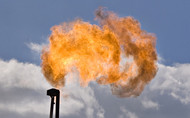Obama Issues Pollution Rules for America Gas Wells
 The U.S. Environmental Protection Agency issued the first rules to combat air pollution from natural-gas drilling, while giving companies until 2015 to meet the most stringent requirements opposed by the energy industry.
The U.S. Environmental Protection Agency issued the first rules to combat air pollution from natural-gas drilling, while giving companies until 2015 to meet the most stringent requirements opposed by the energy industry. The regulations will primarily affect the estimated 13,000 wells a year drilled using hydraulic fracturing, or fracking, to free underground gas in shale formations. The EPA rejected a bid by the American Petroleum Institute to exempt a number of wells from the requirements altogether.
“The president has been clear that he wants to continue to expand production of important domestic resources like natural gas, and today’s standard supports that goal while making sure these fuels are produced without threatening the health of the American people,” EPA Administrator Lisa Jackson, appointed by President Barack Obama, said today in a statement.
An EPA draft of the rule would have put the requirements into effect in about 60 days. The final regulation delays until Jan. 1, 2015, a requirement that drillers capture gases when first tapping a well. Operators must burn off that gas during the phase-in period, the EPA said.
The EPA proposed the rule last year to focus on fracking, in which millions of gallons of chemically treated water are forced underground to break up rock and free gas. The method opened vast new shale gas deposits and helped push gas prices to the lowest level in a decade. Gas for May delivery touched $1.94 per million British thermal units today, the lowest intraday price since January 2002.
The rules force drillers of new wells to capture smog- forming compounds and other substances that are now often released into the air or flared off when a well is tapped. The process also results in methane, the primary component of natural gas, being captured. Half the new wells already use this technology, according to the EPA.
Devon Energy Corp. (DVN) has said 90 percent its wells capture the gas and Southwestern Energy Co. (SWN) says almost all wells in the Marcellus and Fayetteville shale formations collect the gas already.
 “Every molecule of gas you let escape out into the air is a molecule of gas you can’t sell,” Tim Hartley, a spokesman for Oklahoma City-based Devon, said in an interview. The EPA analysis says that drillers may make $11 million to $19 million a year after paying for the equipment to comply with the rule, because they can sell the gas that otherwise would escape into the air.
“Every molecule of gas you let escape out into the air is a molecule of gas you can’t sell,” Tim Hartley, a spokesman for Oklahoma City-based Devon, said in an interview. The EPA analysis says that drillers may make $11 million to $19 million a year after paying for the equipment to comply with the rule, because they can sell the gas that otherwise would escape into the air. Lobbyists for companies including Chesapeake Energy Corp. (CHK) sought to delay and scale back the rule while rebutting environmentalists’ claims that fracking causes air pollution.
“Overall, EPA has made some important adjustment in the rules that allow” the industry to comply, Howard Feldman, research director for the American Petroleum Institute in Washington, said in an interview. “Most of the changes were constructive.”
The group had argued to the Obama administration that the equipment required to capture the gas as required by the EPA rules wasn’t available in sufficient quantities. In delaying the requirement, EPA echoed that assessment.
The EPA added incentives to prod drillers to use a technology called green completions in which gas is trapped. For example, companies that refracture a well and use green completions won’t be subject to state permitting requirements, according to EPA documents.
“Given sufficient ramp-up time, the cost of green completions is expected to be manageable or even positive net of revenue from selling captured methane,” Benjamin Salisbury, a senior energy policy analyst at FBR Capital Markets Corp. in Arlington, Virginia, said in a research note. “We view the final rules as a strong indication of the Obama Administration’s increasing focus on the economic and environmental benefits of shale gas.”
Environmentalists said the incentives are crafted to encourage action by companies.
“I wish there was no phase-in period,” David Doniger, policy director for the climate and clean air program at the Natural Resources Defense Council in Washington, said in an interview. “But the standards contain incentives for companies to do the right thing before the 2015 deadline.”
At the smokestack, power generated from gas emits about half the carbon dioxide as coal, earning it favor with some environmental groups worried about climate change. Research on emissions from fracking itself has prompted questions about whether gas is friendlier to the climate because of methane releases at the well.
Stray emissions from the drilling process can change the calculation that natural gas is cleaner. Some of the largest air emissions occur during the initial three to 10-day period called “flow back,” when fracturing fluids, water and reservoir gas come to the surface at a high velocity and volume, according to the EPA. Systems required by the EPA rule would separate water from the gas, and feed it into a pipeline.
You can return to the main Market News page, or press the Back button on your browser.

